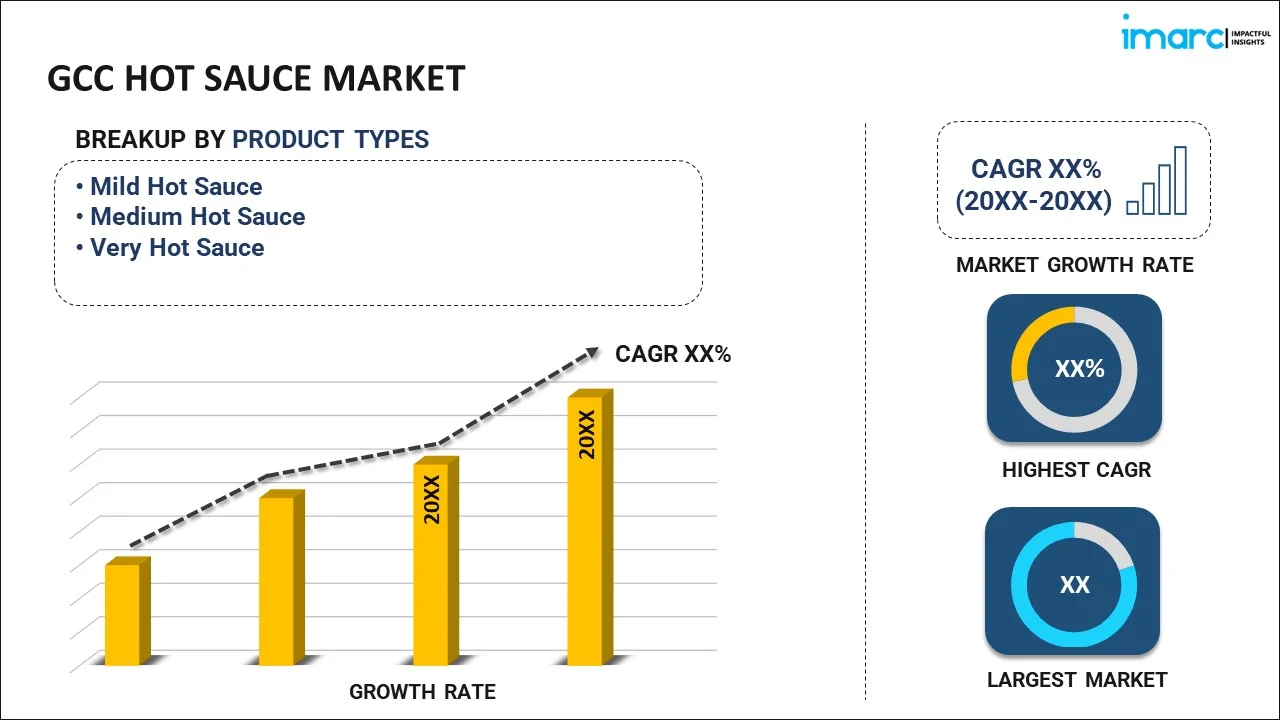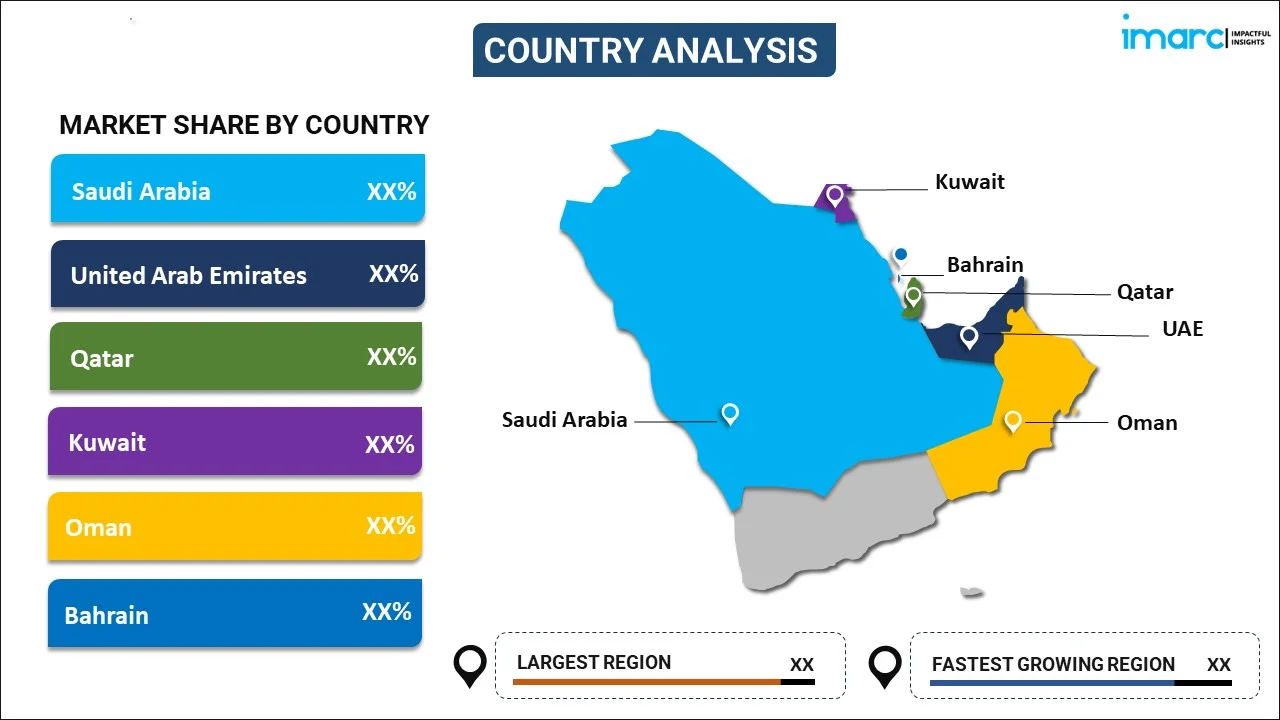
GCC Hot Sauce Market Report by Product Type (Mild Hot Sauce, Medium Hot Sauce, Very Hot Sauce), Packaging Type (Jars, Bottles, and Others), Application (Cooking Sauce, Table Sauce), End Use (Commercial, Household), and Country 2025-2033
Market Overview:
The GCC hot sauce market size reached USD 114.0 Million in 2024. Looking forward, IMARC Group expects the market to reach USD 223.6 Million by 2033, exhibiting a growth rate (CAGR) of 7.8% during 2025-2033. The growing adoption of condiments to enhance the flavor of several food products, increasing social media influence, and rising number of cafes, restaurants, hotels, pubs, clubs, resorts, and other food chain services represent some of the key factors driving the market.
|
Report Attribute
|
Key Statistics
|
|---|---|
|
Base Year
|
2024 |
|
Forecast Years
|
2025-2033
|
|
Historical Years
|
2019-2024
|
| Market Size in 2024 | USD 114.0 Million |
| Market Forecast in 2033 | USD 223.6 Million |
| Market Growth Rate (2025-2033) | 7.8% |
A hot sauce is a condiment that is purposely crafted to provide a spicy and piquant flavor to various dishes. It is made from a combination of ingredients, such as chili peppers, spices, vinegar, and other complementary ingredients, that are specifically selected for their heat level and flavor profile. It is widely available in a wide range of heat levels, from mild to extremely hot, to cater to the different preferences and tolerances for spiciness among individuals. It offers antioxidants and vitamins A and C that enhance overall health and well-being. It can elevate the sensory experience of food and increase palatability. It may help boost metabolism and promote fat burning among individuals. It can trigger the release of endorphins, which are natural painkillers in the body that provide a temporary sense of relief from pain or discomfort. It can open nasal passages and provide temporary relief from congestion, which makes it a popular choice during cold and flu seasons. As it is widely employed in various culinary applications, such as burgers, fish tacos, eggs, pizza, salads, stews, and noodles, to enhance the flavor of dishes, the demand for hot sauce is rising in the GCC region.
GCC Hot Sauce Market Trends:
At present, the increasing adoption of hot sauces, as they stimulate the secretion of gastric juices and aid in the breakdown of food, represents one of the major factors influencing the market positively in the GCC region. Moreover, the wide availability of hot sauce via supermarkets, hypermarkets, and convenience and online stores in the GCC region is strengthening the growth of the market. Apart from this, the growing demand for hot sauces on account of the increasing social media influence is offering a positive market outlook in the region. In line with this, the rising number of cafes, restaurants, hotels, pubs, clubs, and other food chain services in the region is contributing to the growth of the market. Besides this, the increasing adoption of condiments to enhance the flavor of several food products is offering lucrative growth opportunities to industry players. In addition, there is a rise in the demand for cost-effective and premium-quality food products among individuals. This, along with the growing demand for clean-label ingredients due to the increasing awareness about the harmful impacts of chemical-based products among the masses is positively influencing the market in the GCC region. Additionally, key players are introducing low-sodium, low-sugar, and even organic variants of hot sauces, which is supporting the growth of the market in the GCC region.
GCC Hot Sauce Market Segmentation:
IMARC Group provides an analysis of the key trends in each segment of the GCC hot sauce market report, along with forecasts at the regional and country levels for 2025-2033. Our report has categorized the market based on product type, packaging type, application, and end use.
Product Type Insights:

- Mild Hot Sauce
- Medium Hot Sauce
- Very Hot Sauce
The report has provided a detailed breakup and analysis of the market based on the product type. This includes mild hot sauce, medium hot sauce, and very hot sauce.
Packaging Type Insights:
- Jars
- Bottles
- Others
A detailed breakup and analysis of the market based on the packaging type has also been provided in the report. This includes jars, bottles, and others.
Application Insights:
- Cooking Sauce
- Table Sauce
A detailed breakup and analysis of the market based on the application has also been provided in the report. This includes cooking sauce and table sauce.
End Use Insights:
- Commercial
- Household
A detailed breakup and analysis of the market based on the end use has also been provided in the report. This includes commercial and household.
Country Insights:

- Saudi Arabia
- UAE
- Qatar
- Bahrain
- Kuwait
- Oman
The report has also provided a comprehensive analysis of all the major regional markets, which include Saudi Arabia, UAE, Qatar, Bahrain, Kuwait, and Oman.
Competitive Landscape:
The report has also provided a comprehensive analysis of the competitive landscape in the market. Competitive analysis such as market structure, key player positioning, top winning strategies, competitive dashboard, and company evaluation quadrant has been covered in the report. Also, detailed profiles of all major companies have been provided.
GCC Hot Sauce Market Report Coverage:
| Report Features | Details |
|---|---|
| Base Year of the Analysis | 2024 |
| Historical Period | 2019-2024 |
| Forecast Period | 2025-2033 |
| Units | Million USD |
| Scope of the Report | Exploration of Historical and Forecast Trends, Industry Catalysts and Challenges, Segment-Wise Historical and Predictive Market Assessment:
|
| Product Types Covered | Mild Hot Sauce, Medium Hot Sauce, Very Hot Sauce |
| Packaging Types Covered | Jars, Bottles, Others |
| Applications Covered | Cooking Sauce, Table Sauce |
| End Uses Covered | Commercial, Household |
| Countries Covered | Saudi Arabia, UAE, Qatar, Bahrain, Kuwait, Oman |
| Customization Scope | 10% Free Customization |
| Post-Sale Analyst Support | 10-12 Weeks |
| Delivery Format | PDF and Excel through Email (We can also provide the editable version of the report in PPT/Word format on special request) |
Key Questions Answered in This Report:
- How has the GCC hot sauce market performed so far and how will it perform in the coming years?
- What has been the impact of COVID-19 on the GCC hot sauce market?
- What is the breakup of the GCC hot sauce market on the basis of product type?
- What is the breakup of the GCC hot sauce market on the basis of packaging type?
- What is the breakup of the GCC hot sauce market on the basis of application?
- What is the breakup of the GCC hot sauce market on the basis of end use?
- What are the various stages in the value chain of the GCC hot sauce market?
- What are the key driving factors and challenges in the GCC hot sauce market?
- What is the structure of the GCC hot sauce market and who are the key players?
- What is the degree of competition in the GCC hot sauce market?
Key Benefits for Stakeholders:
- IMARC’s report offers a comprehensive quantitative analysis of various market segments, historical and current market trends, market forecasts, and dynamics of the GCC hot sauce market from 2019-2033.
- The research study provides the latest information on the market drivers, challenges, and opportunities in the GCC hot sauce market.
- Porter's five forces analysis assist stakeholders in assessing the impact of new entrants, competitive rivalry, supplier power, buyer power, and the threat of substitution. It helps stakeholders to analyze the level of competition within the GCC hot sauce industry and its attractiveness.
- Competitive landscape allows stakeholders to understand their competitive environment and provides an insight into the current positions of key players in the market.
Need more help?
- Speak to our experienced analysts for insights on the current market scenarios.
- Include additional segments and countries to customize the report as per your requirement.
- Gain an unparalleled competitive advantage in your domain by understanding how to utilize the report and positively impacting your operations and revenue.
- For further assistance, please connect with our analysts.
 Inquire Before Buying
Inquire Before Buying
 Speak to an Analyst
Speak to an Analyst
 Request Brochure
Request Brochure
 Request Customization
Request Customization




.webp)




.webp)












